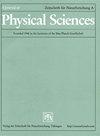放电中HF的非平衡解离:振动激发的作用
IF 1.3
4区 物理与天体物理
Q4 CHEMISTRY, PHYSICAL
Zeitschrift Fur Naturforschung Section A-A Journal of Physical Sciences
Pub Date : 1978-01-01
DOI:10.1515/zna-1978-0916
引用次数: 0
摘要
通过求解包括e-V(电子-振动)、V-V(振动-振动)和V-T(振动-平移)能量交换在内的振动主方程系统,计算了放电中氢能的解离率。结果表明,只有当e-V泵送速率大于V-T失活速率时,该机制才能获得较大的解离速率。这发生在电子数密度大于1013cm-3的情况下。最后给出并讨论了本文所得结果与用红外强激光器作为振动激励源所得到的结果之间的密切联系。本文章由计算机程序翻译,如有差异,请以英文原文为准。
Non Equilibrium Dissociation of HF in Electrical Discharge: The Role of Vibrational Excitation
Dissociation rates o f H F in electrical discharges have been calculated by solving a system of vibrational master equations, including e-V (electron-vibration), V-V (vibration-vibration) and V-T (vibration-translation) energy exchanges. The results show that large dissociation rates can be obtained by this mechanism only when the e-V pumping rates overcome the V-T deactivating rates. This occurs for electron number densities larger than 1013cm-3 . F inally the close connection o f the present results w ith the corresponding ones obtained by using as vibrational excitation source an IR powerfull laser is shown and discussed.
求助全文
通过发布文献求助,成功后即可免费获取论文全文。
去求助
来源期刊
CiteScore
3.00
自引率
5.60%
发文量
81
审稿时长
3.3 months
期刊介绍:
A Journal of Physical Sciences: Zeitschrift für Naturforschung A (ZNA) is an international scientific journal which publishes original research papers from all areas of experimental and theoretical physics. Authors are encouraged to pay particular attention to a clear exposition of their respective subject, addressing a wide readership. In accordance with the name of our journal, which means “Journal for Natural Sciences”, manuscripts submitted to ZNA should have a tangible connection to actual physical phenomena. In particular, we welcome experiment-oriented contributions.

 求助内容:
求助内容: 应助结果提醒方式:
应助结果提醒方式:


